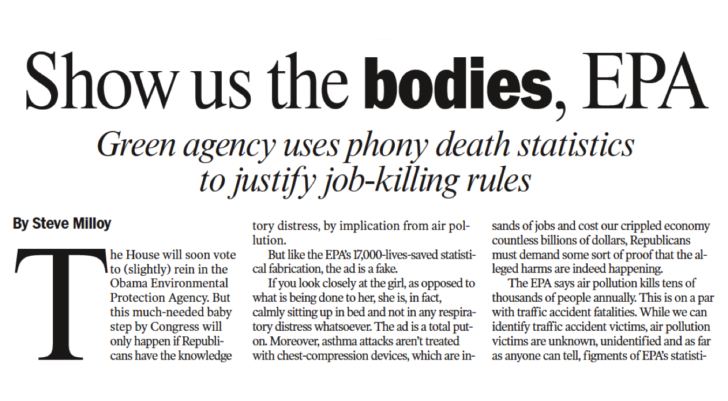Chinese air quality is bad, but made-up statistics touting imaginary deaths don’t fly. Surely with so many deaths, someone can find one death linked with PM2.5?

The media release is below.
Read “Scare Pollution” for the low down on the PM2.5-kills scam.
###
Study: Air pollution battle is crucial to China’s public health
IOP PUBLISHING
China’s measures to improve air quality are working, but more stringent policies should be put in place to safeguard public health, a new study has shown.
Air pollution in China, especially in mega-metropolitan areas, is a matter of concern due to its impact on public health. The study, from Tsinghua University, Beijing, used satellite-derived aerosol optical depth measurements, ground based observations, and air quality simulations to examine the levels of fine particulate matter with aerodynamic diameter less than 2.5 μm (PM2.5) and its adverse health impacts across China.
It is published today in the journal Environmental Research Letters.
Lead author Yixuan Zheng said: “Exposure to PM2.5 can cause adverse health effects including cardiovascular and respiratory morbidity and mortality, and outdoor PM2.5 exposure contributed to approximately 1.22 million deaths in China in 2013.
“The Chinese government has made well-publicised moves to improve air quality and reduce pollution across the whole country, through its Air Pollution Prevention and Control Action Plan (the action plan). Our study marks the first estimates of the impact of this stringent action plan on pollution levels and mortality rates from 2013 to 2015.”
The research confirms the effectiveness of China’s clean air action. The results show that the action plan led to a 21 per cent reduction of population-weighted mean PM2.5 concentration in just two years.
Mr. Zheng said: “China’s government has implemented a series of strict measures to tackle the severe air pollution problem, including promoting end-of-pipe control measures, limiting coal use in small combustion devices, retiring old vehicles, and many others. The large reduction in PM2.5 concentration indicates that those measures are quite effective.”
This study estimated that the premature mortality related to PM2.5 pollution reduced by nine per cent as the consequence of air quality improvement.
Mr Zheng said: “The smaller health benefits compared to reduction in PM2.5 concentration is due to the non-linear relationship between pollution and mortality in current exposure-response functions. PM2.5 concentrations in polluted Chinese provinces are still at the high concentration end, where marginal mortality reductions are relatively small. Therefore, to improve air quality and achieve larger public health benefits in these regions, the government must continue to enforce clean air actions so that public health improves further, and more stringent actions are on the way.
“It should be noted that the exposure-response functions used in this study is primarily developed by epidemiological studies in developed countries, and subject to uncertainties. More direct evidence from local studies could help us to improve the estimates.”
Senior author Professor Qiang Zhang said: “China is now putting tremendous efforts into mitigating PM2.5 levels in several heavily polluted provinces, such as Beijing, Tianjin, and Hebei (BTH region). With the strict control measures, it is most likely China can achieve its goal set in the action plan, i.e., reducing PM2.5 concentration by 25 per cent in the BTH region during 2013-2017. However, continuous efforts should be placed in the future because PM2.5 concentration in BTH is still well above the standard.
“Our study suggests the mortality burdens induced by air pollution are severe in China, indicating that substantial public health benefits can be achieved through further nationwide air quality improvements. China’s government should therefore focus on continuous PM2.5 abatements across the country to improve public welfare.”
###